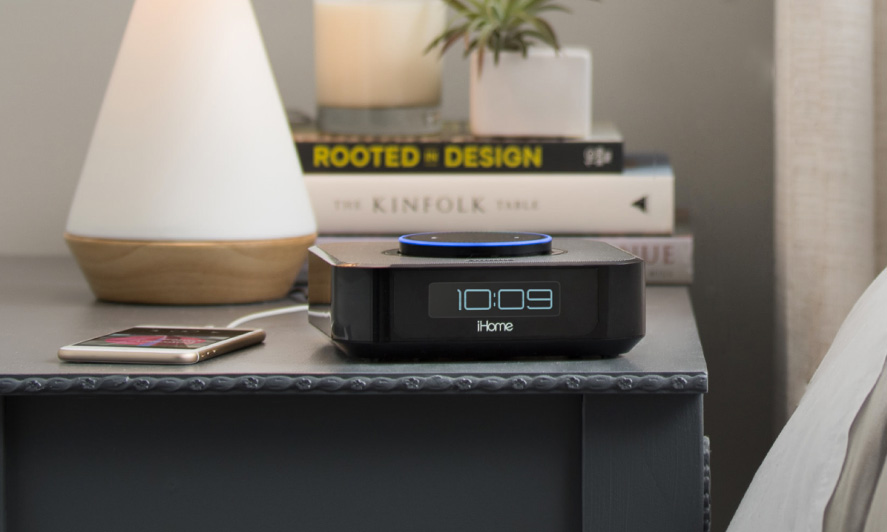Tom's Guide Verdict
While the iHome dock adds a clock and somewhat better sound quality to the Echo Dot, it's too expensive for what it offers.
Pros
- +
Works with first- and second-generation Echo Dots
- +
Includes a USB port for charging a phone
Cons
- -
Battery backup is not for Echo Dot
- -
Expensive
- -
No alarm features in dock
- -
So-so sound quality
Why you can trust Tom's Guide
The Amazon Echo Show has been sitting on my night table for a few weeks now, as its dual speakers make for an excellent alarm clock and ad hoc stereo for my bedroom. But not everyone wants to spend more than $200 for the privilege of having Alexa as a bedside companion.
The iHome Bedside Stereo Speaker System for Amazon Echo Dot ($69) presents itself as a much less expensive alternative: Dock your Dot, and you get improved sound and a small display that shows the time. Sadly, this isn't the next-gen alarm clock I was hoping for.
Design
Measuring 6.7 x 6.7 x 2.2 inches, the iHome is a sizable speaker dock, taking up even more of my nightstand than the substantial Echo Show. The top of the squarish iHome is covered in a gray metal mesh; in the middle is a circular indentation into which the Echo Dot sits.

Toward the front is a series of touch-sensitive metal dots, which are used to dim the iHome's clock display. The rear of the iHome has a small cutout with two USB ports (one of which is used to power the Dot), as well as a 3.5mm headphone jack and a port for the iHome's power.

The iHome also has a backup battery compartment (two AAA batteries are included), but they're used to power only the iHome's display, not the Dot. For true portability for your Dot, you'll want something like the $50 Vaux, which has a built-in battery to power the Dot.
Setup
After nestling my Echo Dot into the iHome, I had to connect an audio jack and a microUSB cable from one device to the other.

From there, it was just a matter of plugging in the iHome. I liked the extra USB port (which delivers 1 amp), which let me charge my iPhone at night.
Performance
The audio from the iHome was certainly better than the sound from the Echo Dot's measly speaker, but it was nothing special. Higher notes, such as the guitar solo in The Beatles' "All You Need is Love" sounded compressed and lifeless, while the bass line was underwhelming. When cranked loud, A-ha's "Take On Me" also sounded muddy at the top end.

Also, because the iHome's speakers face upward, they make it harder for the Echo Dot's microphones to hear you when music is playing loudly. I felt like I had to nearly shout "Alexa!" when the iHome was at higher volumes.
Alarm Clock … Kind Of
The iHome is little more than a speaker with a clock on the front. Although you can set an alarm using an Alexa voice command, you can't control any of the Dot's features, nor can you set — or more importantly, snooze or stop — an alarm by pressing a button on the iHome. You have to say, "Alexa, snooze," or "Alexa, stop," as you would regardless of whether you were using the iHome.
MORE: Amazon Echo Review - Tom's Guide

One of the best things about any traditional alarm clock is that you can slap a button to get an extra 10 minutes of Zzz's. Having to tell Alexa to do so defeats the purpose of having a clock in the first place. In fact, you even have to set the time on the iHome's clock manually, rather than it sync with Alexa through the Dot.
Bottom Line
An Alexa-powered alarm clock is a great idea, but that's not what the iHome Bedside Stereo Speaker System is. It's basically a mediocre speaker that happens to have a clock and a small cutout for an Echo Dot.
If there had been greater integration with Alexa, such as the ability to set an alarm, then it might have been worth its $70 price. But if you're looking for something to make your Echo Dot sound better, you're better off with one of these cheap Bluetooth speakers, each of which costs less than $50.

Michael A. Prospero is the U.S. Editor-in-Chief for Tom’s Guide. He oversees all evergreen content and oversees the Homes, Smart Home, and Fitness/Wearables categories for the site. In his spare time, he also tests out the latest drones, electric scooters, and smart home gadgets, such as video doorbells. Before his tenure at Tom's Guide, he was the Reviews Editor for Laptop Magazine, a reporter at Fast Company, the Times of Trenton, and, many eons back, an intern at George magazine. He received his undergraduate degree from Boston College, where he worked on the campus newspaper The Heights, and then attended the Columbia University school of Journalism. When he’s not testing out the latest running watch, electric scooter, or skiing or training for a marathon, he’s probably using the latest sous vide machine, smoker, or pizza oven, to the delight — or chagrin — of his family.
